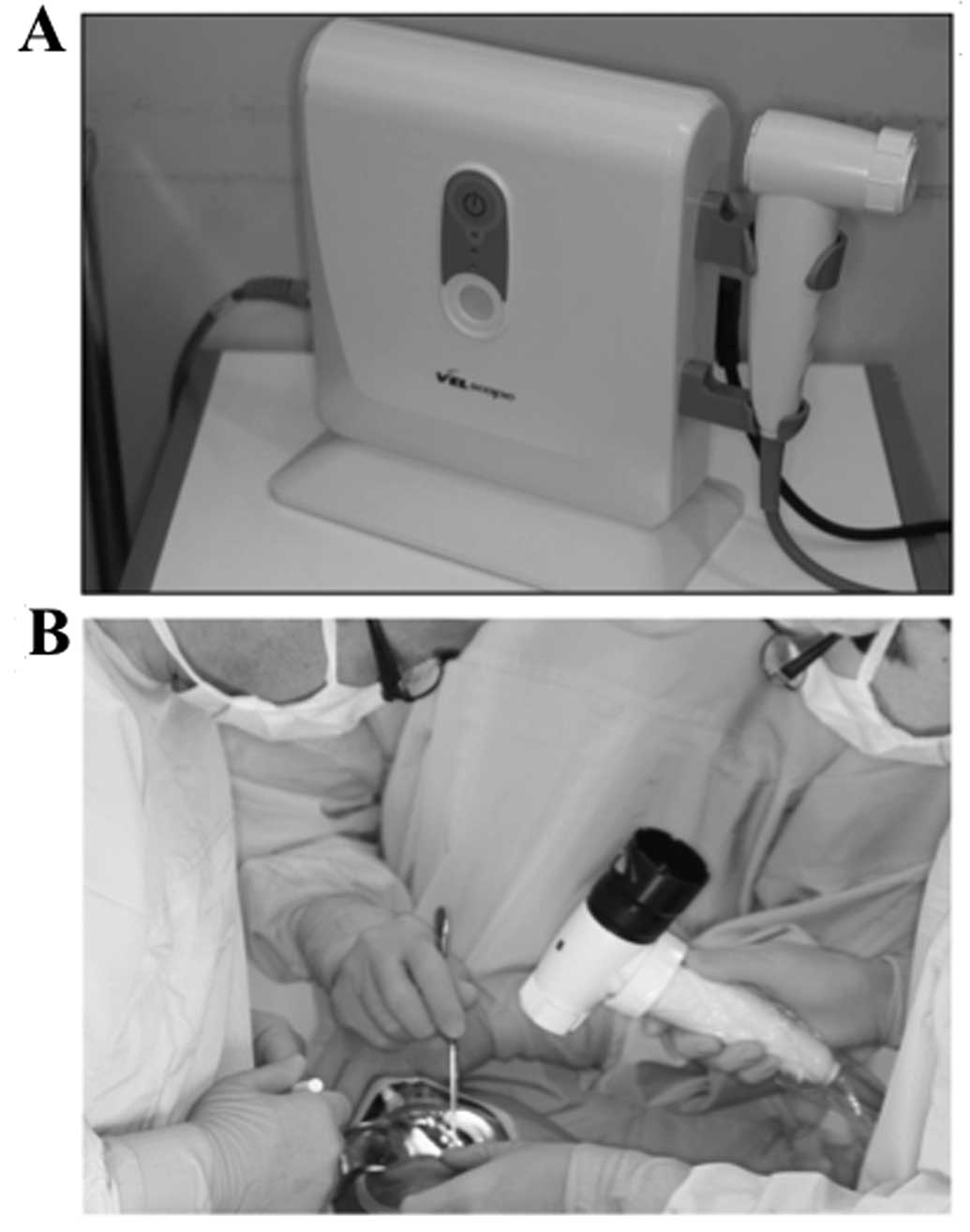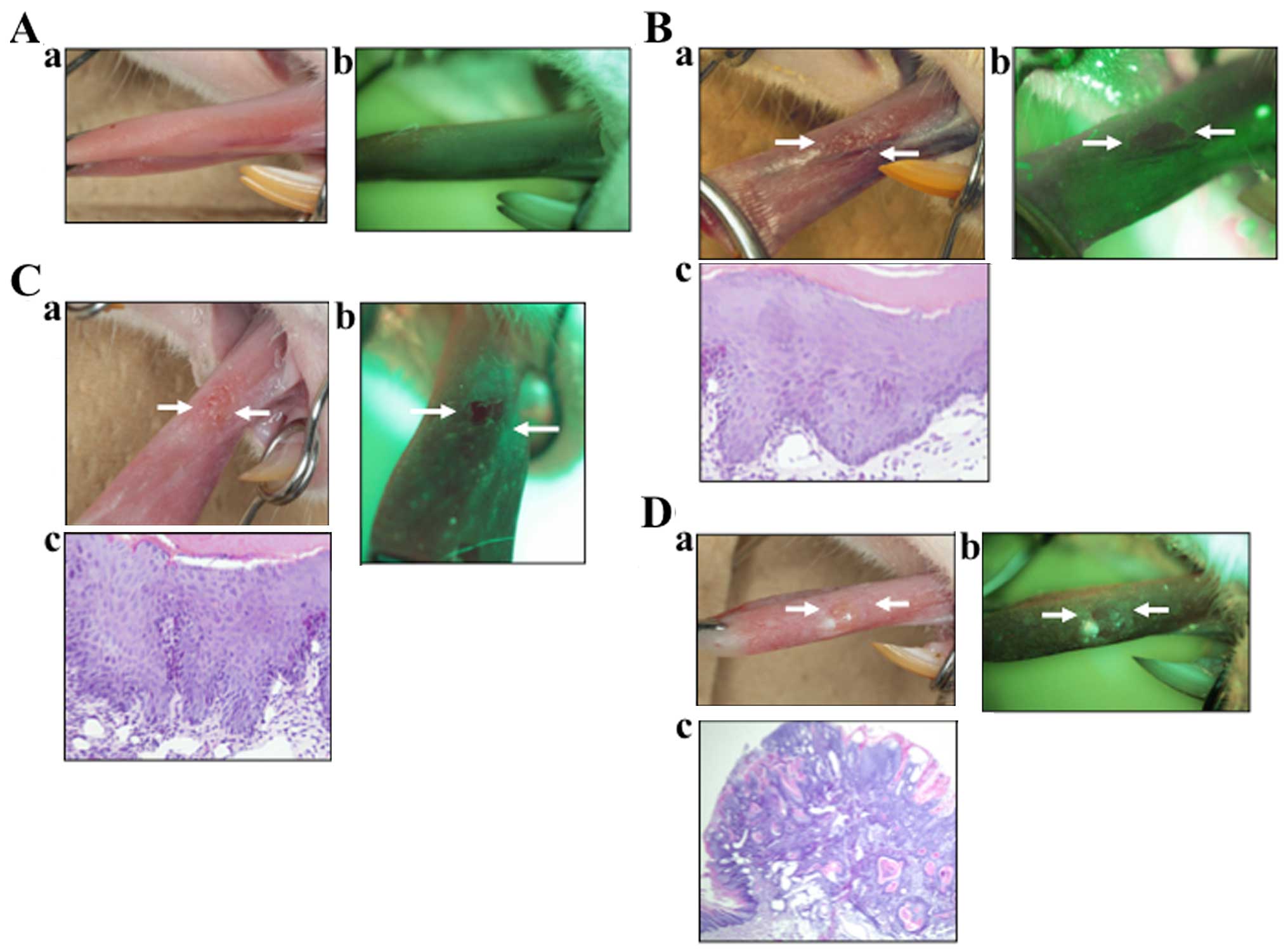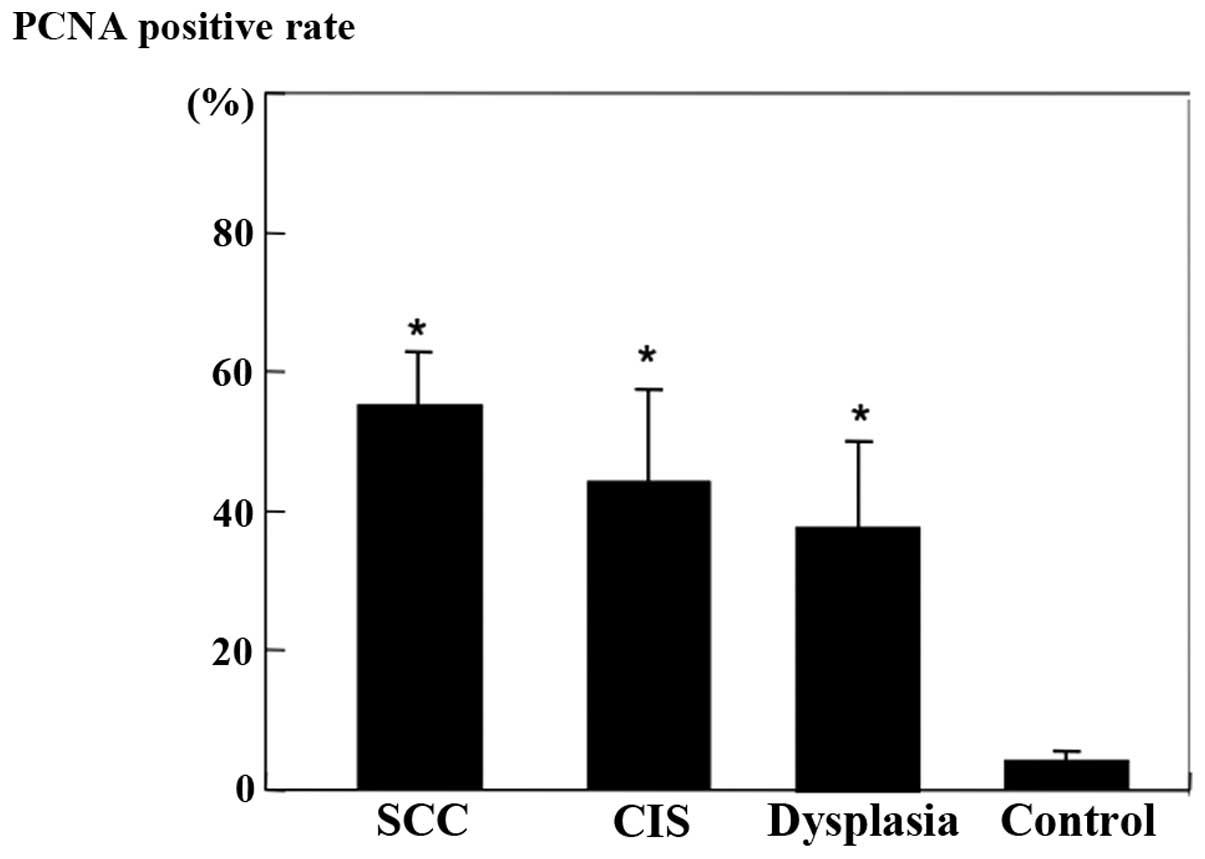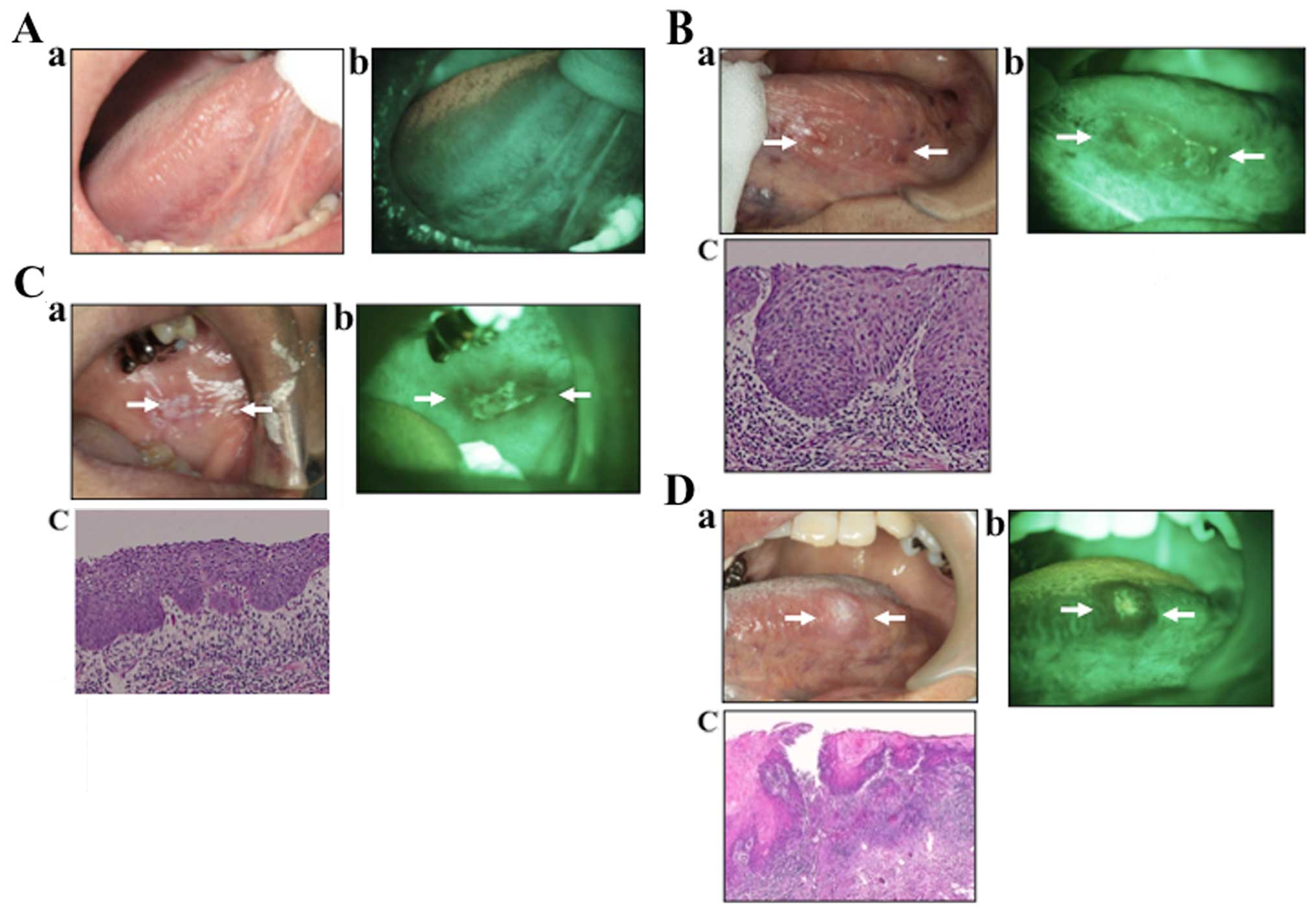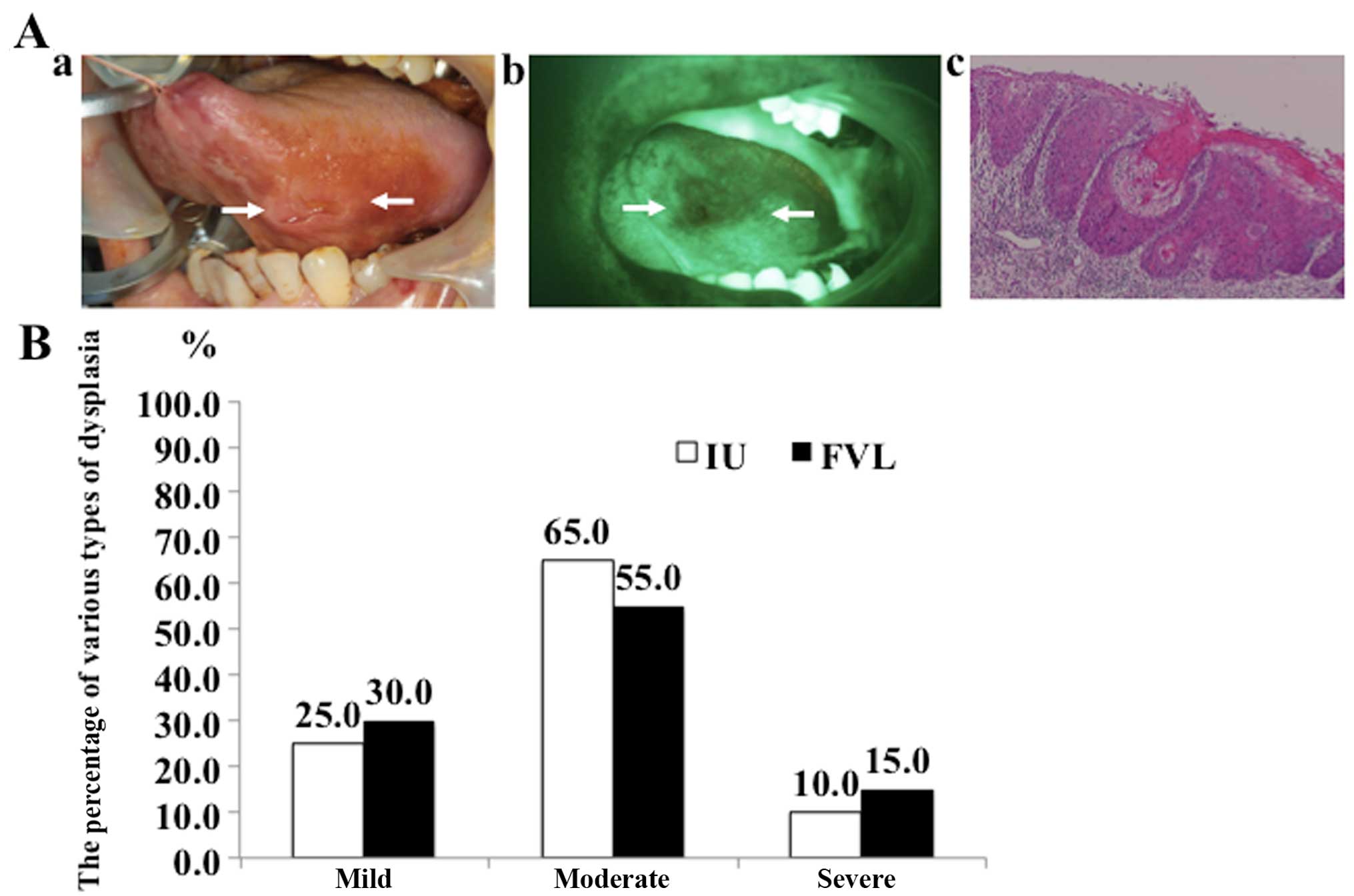|
1
|
Chen YJ, Lin SC, Kao T, Chang CS, Hong PS,
Shieh TM and Chang KW: Genome-wide profiling of oral squamous cell
carcinoma. J Pathol. 204:326–332. 2004. View Article : Google Scholar : PubMed/NCBI
|
|
2
|
Pentenero M, Gandolfo S and Carrozzo M:
Importance of tumor thickness and depth of invasion in nodal
involvement and prognosis of oral squamous cell carcinoma: a review
of the literature. Head Neck. 27:1080–1091. 2005. View Article : Google Scholar : PubMed/NCBI
|
|
3
|
Myers JN, Elkins T, Roberts D and Byers
RM: Squamous cell carcinoma of the tongue in young adults:
increasing incidence and factors that predict treatment outcomes.
Otolaryngol Head Neck Surg. 122:44–51. 2000. View Article : Google Scholar : PubMed/NCBI
|
|
4
|
Choong N and Vokes E: Expanding role of
the medical oncologist in the management of head and neck cancer.
CA Cancer J Clin. 58:32–53. 2008. View Article : Google Scholar
|
|
5
|
De Veld DCG, Witjes MJH, Sterenborg HJCM
and Roodenburg JLN: The status of in vivo autofluorescence
spectroscopy and imaging for oral oncology. Oral Oncol. 41:117–131.
2005. View Article : Google Scholar : PubMed/NCBI
|
|
6
|
Onizawa K, Saginoya H, Furuya Y, Yoshida H
and Fukuda H: Usefulness of fluorescence photography for diagnosis
of oral cancer. Int J Oral Maxillofac Surg. 28:206–210. 1999.
View Article : Google Scholar : PubMed/NCBI
|
|
7
|
Onizawa K, Saginoya H, Furuya Y and
Yoshida H: Fluorescence photography as a diagnostic method for oral
cancer. Cancer Lett. 108:61–66. 1996. View Article : Google Scholar : PubMed/NCBI
|
|
8
|
Svistun E, Alizadeh-Naderi R, El-Naggar A,
Jacob R, Gillenwater A and Richards-Kortum R: Vision enhancement
system for detection of oral cavity neoplasia based on
autofluorescence. Head Neck. 26:205–215. 2004. View Article : Google Scholar : PubMed/NCBI
|
|
9
|
Lane PM, Gilhuly T, Whitehead P, Zeng H,
Poh CF, Ng S, Williams PM, Zhang L, Rosin MP and MacAulay CE:
Simple device for the direct visualization of oral-cavity tissue
fluorescence. J Biomed Opt. 11:0240062006. View Article : Google Scholar : PubMed/NCBI
|
|
10
|
Poh CF, Ng SP, Williams PM, Zhang L,
Laronde DM, Lane P, Macaulay C and Rosin MP: Direct fluorescence
visualization of clinically occult high-risk oral premalignant
disease using a simple hand-held device. Head Neck. 29:71–76. 2007.
View Article : Google Scholar
|
|
11
|
Qu J, MacAulay C, Lam S and Palcic B:
Laser induced fluorescence spectroscopy at endoscopy: Tissue
optics, Monte Carlo modeling and in vivo measurements. Opt Eng.
34:3334–3343. 1995. View Article : Google Scholar
|
|
12
|
Kois JC and Truelove E: Detecting oral
cancer: a new technique and case reports. Dent Today. 25:94–97.
96–97. 2006.PubMed/NCBI
|
|
13
|
Poh CF, Zhang L, Anderson DW, Durham JS,
Williams PM, Priddy RW, Berean KW, Ng S, Tseng OL, MacAulay C, et
al: Fluorescence visualization detection of field alterations in
tumor margins of oral cancer patients. Clin Cancer Res.
12:6716–6722. 2006. View Article : Google Scholar : PubMed/NCBI
|
|
14
|
Müller MG, Valdez TA, Georgakoudi I,
Backman V, Fuentes C, Kabani S, Laver N, Wang Z, Boone CW, Dasari
RR, et al: Spectroscopic detection and evaluation of morphologic
and biochemical changes in early human oral carcinoma. Cancer.
97:1681–1692. 2003. View Article : Google Scholar : PubMed/NCBI
|
|
15
|
Balevi B: Evidence-based decision making:
Should the general dentist adopt the use of the VELscope for
routine screening for oral cancer? J Can Dent Assoc. 73:603–606.
2007.PubMed/NCBI
|
|
16
|
Richards-Kortum R and Sevick-Muraca E:
Quantitative optical spectroscopy for tissue diagnosis. Annu Rev
Phys Chem. 47:555–606. 1996. View Article : Google Scholar : PubMed/NCBI
|
|
17
|
Drezek R, Sokolov K, Utzinger U, Boiko I,
Malpica A, Follen M and Richards-Kortum R: Understanding the
contributions of NADH and collagen to cervical tissue fluorescence
spectra: modeling, measurements, and implications. J Biomed Opt.
6:385–396. 2001. View Article : Google Scholar : PubMed/NCBI
|
|
18
|
Drezek R, Brookner C, Pavlova I, Boiko I,
Malpica A, Lotan R, Follen M and Richards-Kortum R:
Autofluorescence microscopy of fresh cervical-tissue sections
reveals alterations in tissue biochemistry with dysplasia.
Photochem Photobiol. 73:636–641. 2001. View Article : Google Scholar : PubMed/NCBI
|
|
19
|
Pavlova I, Sokolov K, Drezek R, Malpica A,
Follen M and Richards-Kortum R: Microanatomical and biochemical
origins of normal and precancerous cervical autofluorescence using
laser-scanning fluorescence confocal microscopy. Photochem
Photobiol. 77:550–555. 2003. View Article : Google Scholar : PubMed/NCBI
|
|
20
|
Tsuboi S, Sato K and Nakajima K: Gendai no
Seikagaku. Kanehara Publishing; Tokyo: pp. 55–56. 1992
|
|
21
|
Sawataishi M, Karaki Y, Kawaguchi M,
Saitoh M, Saeki T, Yamada A, Shimazaki K, Munakata S, Sakamoto T,
Shinbo T, et al: The examination of the coloring mechanism of the
human esophageal epithelium by Lugol's solution. J Jpn
Bronchoesophagol Soc. 40:252–257. 1989. View Article : Google Scholar
|
|
22
|
Yokoo K, Noma H, Inoue T, Hashimoto S and
Shimono M: Cell proliferation and tumor suppressor gene expression
in iodine unstained area surrounding oral squamous cell carcinoma.
Int J Oral Maxillofac Surg. 33:75–83. 2004. View Article : Google Scholar
|















